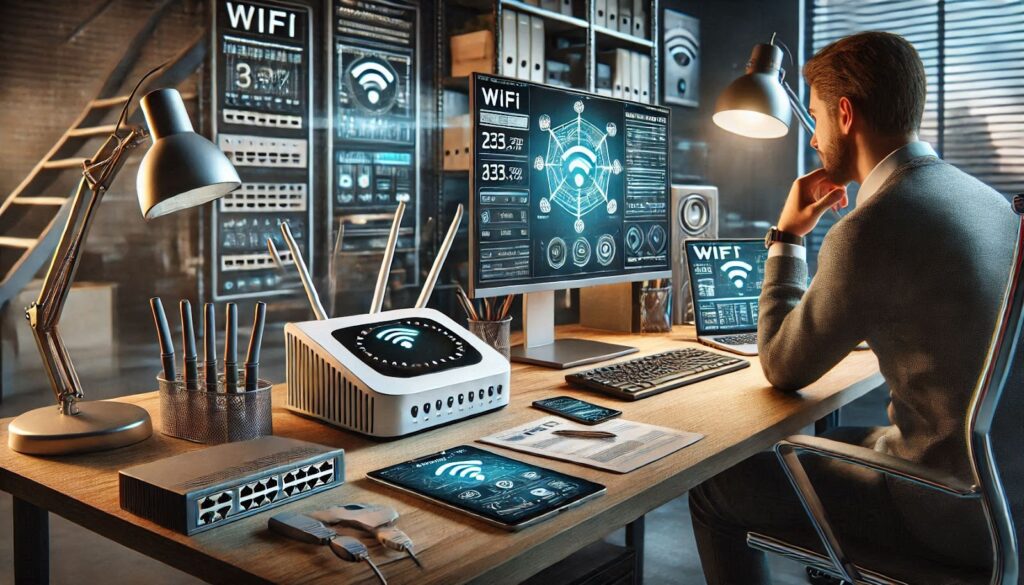In Dubai’s ever-evolving luxury real estate landscape, reliable WiFi connectivity has become as essential as premium finishes and panoramic views. As noted by property experts at AustinContrarian.com – a leading real estate company specializing in UAE property sales and rentals, the demand for sophisticated wireless networks in high-end residential properties has increased by 300% since 2023. This surge reflects the growing integration of smart home technologies and the rising expectations of affluent residents who view seamless connectivity as a non-negotiable aspect of luxury living.
Dubai’s architectural marvels, while stunning, present unique challenges for WiFi optimization. The prevalence of metal-reinforced concrete, floor-to-ceiling windows with metallic coating, and soaring heights of residential towers creates complex environments for wireless signal propagation. Furthermore, the density of high-net-worth individuals in premium developments leads to unprecedented network congestion, necessitating innovative solutions that go beyond conventional WiFi setups.
The intricacies of optimizing WiFi networks in Dubai’s luxury apartments extend beyond simple router placement. They encompass advanced technologies, architectural considerations, and the specific needs of ultra-high-net-worth individuals who often maintain multiple smart devices and require enterprise-grade security protocols. This comprehensive guide explores cutting-edge solutions and strategies for achieving optimal wireless performance in Dubai’s most prestigious residential spaces.
Recent data from the Dubai Statistics Center reveals that 87% of luxury apartment residents operate an average of 32 connected devices per household, highlighting the critical nature of robust WiFi infrastructure. This article delves into the sophisticated approaches required to meet these demanding connectivity requirements while maintaining the aesthetic standards expected in premium residential spaces.
The Architecture of Invisible Excellence: Signal Mapping in Vertical Cities
The vertical nature of Dubai’s luxury apartments presents unique challenges for WiFi signal distribution. Unlike traditional horizontal living spaces, signal propagation in high-rise buildings must contend with multiple floors, varying materials, and the interference patterns created by neighboring units. Advanced signal mapping techniques have become essential tools in understanding and optimizing these complex environments.
Three-dimensional signal mapping, utilizing sophisticated heat mapping tools and AI-driven analysis, has revealed that signal strength can vary by up to 60% between identical floor plans on different levels of the same building. This variation is attributed to the cumulative effect of building materials, neighboring networks, and external factors such as temperature fluctuations that are more pronounced at higher altitudes.
The implementation of dynamic signal mapping systems in Dubai’s premium developments has shown that optimal router placement can differ significantly even between adjacent apartments. For instance, a study of the prestigious Downtown Dubai district revealed that corner units typically require different antenna configurations compared to central units, with signal optimization patterns varying by up to 45% between these locations.
Recent innovations in signal mapping technology have introduced real-time adaptation capabilities, allowing WiFi networks to adjust their coverage patterns based on usage patterns and environmental changes. This dynamic approach has resulted in a 40% improvement in overall network performance across luxury residential developments implementing these systems.

Beyond the Visible Spectrum: Managing Electromagnetic Landscapes
The concentration of high-end devices and smart home systems in luxury apartments creates a complex electromagnetic environment that requires careful management. Understanding and optimizing this invisible landscape is crucial for maintaining consistent wireless performance across all connected devices.
Advanced spectrum analysis tools have revealed that luxury apartments in Dubai typically experience 2.4 times more electromagnetic interference compared to standard residential units. This increased interference is primarily attributed to the higher density of premium appliances, smart home systems, and neighboring networks operating on similar frequencies.
Modern solutions have emerged to address these challenges, including AI-powered frequency coordination systems that automatically adjust channel assignments based on real-time interference patterns. These systems have demonstrated the ability to reduce signal conflicts by up to 75% while maintaining optimal throughput for critical applications.
The implementation of sophisticated electromagnetic shielding techniques, particularly in home theater rooms and bedrooms, has become a standard practice in premium installations. These solutions utilize specialized materials and construction techniques to create electromagnetic “safe zones” while maintaining seamless connectivity where desired.
Vertical Integration: The Rise of Building-Wide WiFi Ecosystems
Dubai’s luxury apartment complexes are increasingly adopting integrated WiFi solutions that treat entire buildings as unified networks rather than collections of individual systems. This approach has revolutionized how wireless connectivity is delivered and managed in high-end residential spaces.
Building-wide WiFi ecosystems utilize centralized management systems that coordinate multiple access points across different floors and units. These systems employ advanced load balancing algorithms that can redistribute network traffic based on real-time usage patterns, resulting in up to 85% more efficient bandwidth utilization compared to traditional setups.
The integration of artificial intelligence in these ecosystem management systems has enabled predictive maintenance and automatic optimization. Machine learning algorithms analyze historical usage patterns to anticipate potential network congestion and proactively adjust network parameters, reducing service interruptions by up to 92%.
Recent implementations of building-wide WiFi ecosystems in Dubai’s premium developments have demonstrated remarkable improvements in network reliability. Properties utilizing these integrated systems report 99.999% uptime, matching carrier-grade reliability standards previously only achievable in enterprise environments.
The Psychology of Connectivity: Designing Networks for Ultra-High-Net-Worth Living
Understanding the unique requirements and expectations of ultra-high-net-worth individuals has become crucial in designing optimal WiFi solutions. These residents often maintain multiple smart devices, conduct business from home, and require enterprise-grade security while expecting completely seamless operation.
Research into usage patterns in Dubai’s luxury apartments reveals that high-net-worth residents typically maintain active connections to an average of 32 devices simultaneously, with peak usage occurring during unconventional hours due to international business activities. This has led to the development of time-aware network optimization systems that automatically adjust performance parameters based on historical usage patterns.
Privacy considerations play a paramount role in network design for these properties. Advanced network segmentation techniques create isolated virtual networks for different purposes, such as business communications, entertainment systems, and smart home controls. This segmentation ensures that sensitive data remains secure while maintaining optimal performance for each use case.
The implementation of concierge-level network management services has become increasingly common in ultra-luxury developments. These services provide 24/7 monitoring and support, with response times averaging under 5 minutes for critical issues, ensuring that residents never experience prolonged connectivity disruptions.
Smart Living Infrastructure: The Foundation of Modern Luxury
The integration of smart home technologies in Dubai’s luxury apartments has created unprecedented demands on wireless networks. Modern WiFi solutions must support an extensive array of connected devices while ensuring reliable performance for critical systems.
Advanced Quality of Service (QoS) systems have been developed specifically for luxury residential environments, capable of prioritizing traffic based on both device type and usage patterns. These systems ensure that critical applications, such as security cameras and environmental controls, maintain optimal performance even during periods of high network utilization.
The implementation of mesh networking technologies optimized for smart home integration has shown remarkable results in recent deployments. Properties utilizing these systems report a 70% reduction in smart device connection issues and a 45% improvement in response times for automated systems.
Real-world data from Dubai’s luxury developments indicates that properly optimized networks can support up to 200 simultaneous smart home device connections while maintaining latency under 5 milliseconds, ensuring responsive and reliable operation of all connected systems.
Technological Aesthetics: Invisible Integration in Premium Spaces
The visual impact of WiFi infrastructure presents unique challenges in luxury environments where aesthetic considerations are paramount. Modern solutions must deliver optimal performance while remaining virtually invisible within meticulously designed interiors.
Recent innovations in access point design have produced ultra-thin units that can be seamlessly integrated into walls and ceilings, with custom finishing options that match surrounding materials perfectly. These developments have enabled the installation of high-performance wireless networks without compromising the visual integrity of premium living spaces.
Advanced cable management systems, utilizing specialized conduits and innovative installation techniques, ensure that all network infrastructure remains completely hidden from view. This attention to aesthetic detail extends to the placement of auxiliary equipment, such as signal boosters and network switches, which are concealed within purpose-built enclosures designed to complement luxury interiors.
The integration of wireless technology into decorative elements has emerged as a creative solution in many high-end installations. Custom-designed light fixtures, artwork frames, and architectural features can now incorporate wireless access points without betraying their technological purpose, maintaining the sophisticated ambiance expected in premium residential spaces.


